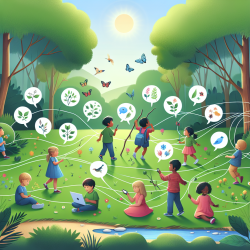Introduction
In the ever-evolving landscape of child development, practitioners are constantly seeking innovative ways to enhance cognitive growth. A groundbreaking study, "Residential neighborhood greenery and children's cognitive development," offers intriguing insights into how the natural environment may play a pivotal role in cognitive development. As a speech-language pathologist, understanding these findings can significantly impact how we approach therapy and support for children.
The Study: Key Findings
The research utilized the E-Risk Longitudinal Study, focusing on a cohort of children in Britain, to explore the impact of residential neighborhood greenery on cognitive development. The study assessed children's cognitive abilities using standardized tests at ages 5, 12, and 18, alongside satellite imagery to measure greenery exposure.
Key findings include:
- Children in greener neighborhoods scored higher on IQ measures at all ages.
- The initial positive association between greenery and cognitive development was not significant after adjusting for socioeconomic factors.
- While greenery was associated with better cognitive abilities, the effect was largely explained by socioeconomic status rather than greenery itself.
Implications for Practitioners
For practitioners in speech-language pathology, these findings emphasize the importance of considering environmental factors in cognitive development. Here are some actionable insights:
- Holistic Assessment: Incorporate environmental factors into assessments. Understanding a child's living environment can provide context for their cognitive abilities.
- Advocate for Green Spaces: Support initiatives that promote access to green spaces in communities, particularly in underprivileged areas.
- Collaboration with Educators: Work with schools to integrate outdoor learning and nature-based activities into the curriculum, which can enhance cognitive engagement.
Encouraging Further Research
While the study highlights the potential cognitive benefits of greenery, it also underscores the complexity of environmental and socioeconomic interactions. Practitioners are encouraged to delve deeper into this research area to better understand the mechanisms at play. Consider the following steps:
- Conduct Local Studies: Collaborate with local schools and communities to study the impact of greenery on cognitive development in diverse settings.
- Interdisciplinary Research: Partner with environmental scientists and urban planners to explore innovative ways to integrate greenery into urban settings.
Conclusion
While greenery alone may not be a magic bullet for cognitive development, it is a valuable component of a multifaceted approach to enhancing children's cognitive abilities. As practitioners, embracing a holistic perspective that includes environmental factors can lead to more effective interventions and better outcomes for children.
To read the original research paper, please follow this link: Residential neighborhood greenery and children's cognitive development.










